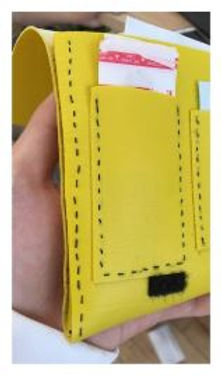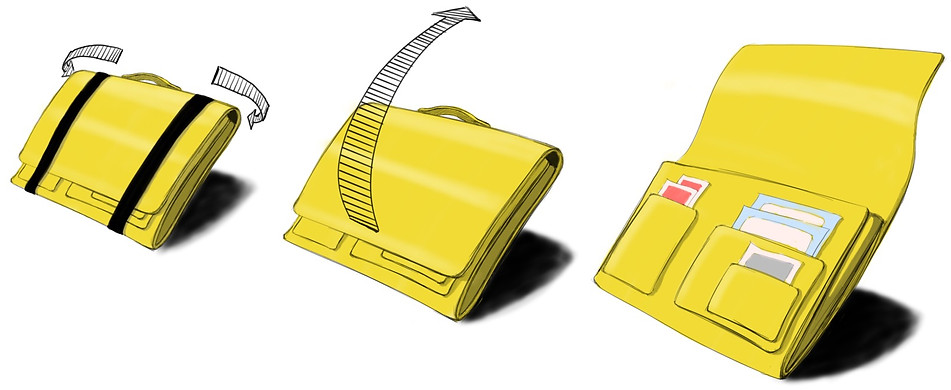

WASP FIGHTER KIT
(WFK)
A personal, portable, sweat-repellant, easy, and customizable first aid kit to deliver prior self-care before the arrival of professional help.
PROJECT INTRO
OVERVIEW
WFK is a personal first aid kit that initially designed for combat trainees to take care of themselves in the first place when encountering common wounds and before the arrival of professional help. By replacing medical content with daily carries, WFK is able to become a personal and portable bag. It applies industrial design and fashion design to complete the project.
MY ROLE: INDUSTRIAL DESIGN
Design research, designing, hands-on sewing and trimming (no machines), prototyping, testing.
DESIGN TOOL
Solidworks, Keyshot, Sketchbook Pro.
TEAM
Individual project.
PROJECT DURATION
Aug 2018 - Oct 2018, 7 weeks
LOCATION
Brooklyn, NY, USA.

KEY TASK
To re-design a first aid kit to address certain issues that bother relevant group(s) of population.
DESIGN PRINCIPLE
-
Re-design to foster health care
-
User friendly
-
Sustainable, environmental friendly
-
Problem solving
PROJECT GOAL
-
Foster immediate self-care
-
Easy operability
-
Personal and portable to carry
-
Durable material
-
Customizable content
-
Foster awareness on self-care
TARGET GROUP
Combat trainees.
GUIDING QUESTION
What're critically needed to make this new FAK that delivers self-care in the very moment with just what's needed for injuries? Can it also increase users' awareness on self-care or health care?
KEY WORD
-
Self-care
-
First aid kit
-
Re-design
-
Personal, portable, and customizable
-
Combat trainees
RESEARCH
KEY ISSUE
-
The common injuries in combat training include scratches, cuts, bruises, and joint injuries.
-
If not taken care, wounds are possible to worsen and lead to infections and etc.
-
Unpredictable amount of usage on public first aid resource.
-
Situations where demands exceed supplies.
_JPG.jpg)
_JPG.jpg)
.jpg)
_JPG.jpg)
COMMON INJURY TREATMENT PACK
-
One instant ice pack
-
Five sticky band-aid
-
Two for each medium and large size of band-aid
-
Three Anti-bacteria towelette for cleaning wounds

INTERVIEW CONCLUSION
-
Public first aid kits are usually located on walls or in offices of coaches.
-
Some trainees have their own kits but because of the size and poor portability the kits are put in lockers with other clothing.
-
Sometimes there is not enough public medical support or refilling for everyone.
-
A kit comes with full content and even if it could be carried, it would disturb body movement during training due to size and weight.
After the interview, I realized that a better way for the trainees to self-care only occurs when there is sufficient medical source for their injuries. Due to unpredictable usage on the public source, it'd be better if trainees prepare their own medical needs based on the training content. That way trainees are also encouraged to foresee scenarios and increase their awareness on self-care by predicting possible injuries and treatment content.
IDEATION

How to become portable and where/when to attach is critical, because that will directly impact training in terms of body movement. How fast and where can they reach to kits for self-care? Now the treatment pack content is clear, but how to fit them in the kit? How to protect them?
DESIGN
PROTOTYPE (ROUND ONE)
Able to attach to punching gloves by a back clip but it disturbs training whenever it involves another one to fight face-to-face. Punches landing on gloves will squeeze the kit and destroy the inside content, especially the instant ice pack.

PROTOTYPE (ROUND TWO)
Velcro closure and visual guidance to replace textual instruction for straightforward understanding on how-to-use. Able to attach on the back of any clothing bags trainees carry to gyms. However the size is too large and kit disturbs body movement. It is loose inside, so the content shakes if one moves.

PROTOTYPE (ROUND THREE)
Adjusted size and added inner pockets to isolate the content by use. The pockets are slightly tight to stabilize each content and prevent shaking that disturbs one's move. Velcro closure remains for easy operation.

PROTOTYPE (ROUND FOUR)
The point is not to make a kit attach with its user's body as long as he/she stays in the training zone. No bothering during training and to stay close just to guarantee easy reach-out are the priorities.


Velcro closure and black-line trimming breaks aesthetics. In order to remove it and apply elastic bands, another round of sewing and making happens. This time, every piece of fabric is doubled to increase appropriate thickness that offers a sense of protection.
I insisted on handcrafting to apply "imperfection is perfect", like how some fashion designers would purposefully leave obvious signs of handcrafting on rings and clothing they make.
FINAL OUTCOME


Personal content.

Easy velcro closure to renew medical tape.

Attach to your waist.

Attach to your backpack.

NEXT STEP
WHAT COULD'VE BEEN DONE BETTER
WHAT'RE EXPECTED TO LEARN NEXT
Attachment. Velcro closure should be applied on the top so it won't need another hook or buckle to assist attaching on pants or bags.
Protection. Although the kit is water repellant, which protects the medical content, the softness is unable to prevent damage from pressing. In this case, the ice pack may be squeezed hard enough to work without being noticed and known.
What could be a better way to think of attachability? Besides personal FAK, what else would customers use it for?
Would it be used for other purpose more than a personal FAK? In what way could I enhance the "handcrafting" sign and make more "imperfection is perfect"?